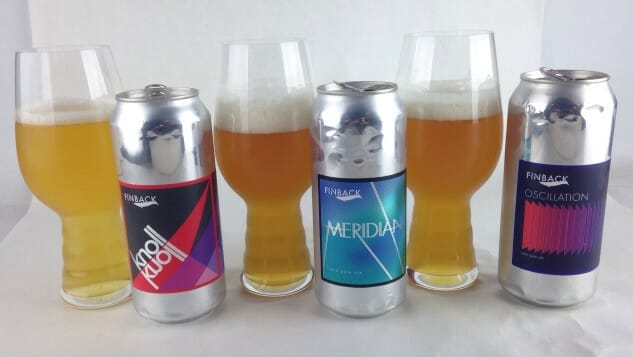
Unwrapping boxes of beer in the Paste office is something I do on a daily basis, but it’s not often you open a box from a new brewery and pull out not one, or two, but three separate IPAs … and no other styles of beer. That sounds to us like making a statement, and it couldn’t help but make me curious about these beers from NYC’s Finback Brewery.
As it turns out, yes, the brewery does produce other beers that aren’t IPA. They’ve been in business for a couple of years now, and have been one of those breweries I’ve seen regularly mentioned in the New York crowd, but have never sampled. Now, with these three IPAs in hand, I figured the obvious way to tackle them would be to taste all three at once.
The three beers are called Knoll, Meridian and Oscillation, and each represents an ascending tier of strength. Knoll, at 5% ABV, is a tad under what you can probably get away with calling “IPA” rather than American pale ale or session IPA. Meridian is right in the middle of the sweet spot at 7% ABV. The rotating hop series Oscillation, meanwhile, should probably be categorized as a DIPA at 8.5% ABV—or at least that’s the category we would have included it in if it was part of our blind tastings. Let’s dive into each.
Finback Brewery Knoll IPA
There’s no description of this beer on either the can or the brewery website (same with Meridian), which leads me to reassert one of my oft-repeated craft beer pet peeves: All breweries, especially small breweries, should make it a priority to have a constantly updated list of their products online. At no point should someone have a chance to drink one of your beers, but be unable to find even a basic description of that beer provided by the brewery. Every time that happens, you’ve just missed out on an opportunity to educate a potential customer about your product.
Now, with that out of the way, let’s talk about the beer. At 5% ABV, as we mentioned above, it’s in a curious place for something that the brewery calls an IPA. Historical record or not, no one makes a 5% ABV beer in 2016 and calls it an IPA—or any beer smaller than 6%, really. It’s a testament to the selling power of the three letters “IPA” that they choose to call it by that name, rather than saying it’s an extremely hoppy pale ale, or even a session IPA. If anything, is this just one more piece of evidence that session IPA is already fading away, when a brewery doesn’t want to label its 5% ABV hoppy beer as one?
Regardless of all that, though, Knoll is a pretty fantastic brew, and easily the most approachable and instantly enjoyable of the three. The initial nose hits you with huge, crazy tropical and stone fruit aromatics that are pretty impressive, and fit in nicely alongside the juicy, low-bitterness hop profiles that have become ascendant in IPA. The hops on the nose are truly huge, without the barest suggestion of malt.
On the palate, the flavors morph a little bit. Lemon and orange citrus come forth more here, with peach-like stone fruit and floral notes as well. In a nice touch, it ends with a bit of clean, crisp, bready graininess that provides just the tiniest (but appreciated) counterpoint to the hops. They keep the hops from 100 percent running away with the beer—instead they only 90 percent run away with the beer, not that we’re complaining. The hop-driven fruitiness hits a perfect point on the residual sweetness scale—quite juicy, without being too sweet. It’s damn good beer, regardless of what the proper classification is.
Rating: 8.6
Finback Brewery Meridian IPA
The thing I was most curious about in tasting these three IPAs side by side was how disparate and unique they would each seem next to each other in terms of profile, and at least between the first two, the answer is “very.”
Meridian simply belongs to a different type of IPA family than Knoll. Instead of the huge blast of tropical fruit on the nose, you instead get a much more intensely resinous, grassy hop character. It’s catty, piney and very dank—the kind of beer where I got a sudden rush of dank hops while just cracking the can open. The flavors carry that resinous hop character, but then present something unusual—a concurrent streak of what tastes like stone fruit (white peach, something like that) running side by side. The pine needles and fruitiness combine to form a pretty unique IPA; two aspects that don’t come together in harmony very easily.
As the beer warms, it becomes even more of an enigma. Several of the tasters here at Paste got strong onion-y character from it, the sort of which you’d expect from Summit hops. Residual sweetness is moderate, about the same as in the Knoll, although the overall effect combines with the stone fruit to remind me a bit of peaches and pears in heavy syrup.
All in all, this IPA is significantly more complex and harder to wrap one’s head around than the instantly embraceable Knoll. It may not be as purely crowd-pleasing, but I enjoyed dissecting some of its more intricate flavors.
Rating: 8.1

Finback Brewery Oscillation IPA 006
Unlike the other two IPAs, this one you can actually find a small amount of information about. It’s a rotating, cyclical hop series that retains its malt bill but changes its hops in each iteration, weighing in at either 8.5% ABV (via Beeradvocate) or 8.1% ABV (via Beermenus). Either way, you’d more easily fit it into the DIPA camp than the single IPA camp.
In terms of profile, Oscillation is definitely closer to Meridian than it is to Knoll, and it reinforces a point of comparison I began to grasp while drinking Meridian: These beers remind me a bit of the double dry-hopped brews we’ve had from the likes of Trillium and Tree House. No, they don’t pour out of the bottle in a frothy, latte-like cascade of haze, but they both have a certain dimension of hop flavor I’ve come to associate with those IPAs that receive bombastic, over-the-top dry hop regimens. It’s a certain intensity of pure, green, grassy hoppiness that reminds you of what hops are—green, flowering plant life. Perhaps it’s simply the Amarillo in this hop bill, which often has a charge of “fresh cut grass” flavor, but the green character here is positively chewy. I see where other tasters have described the beer as more tropical fruity, but to us, it’s the resin and grass that comes out supreme, much in the same way that we perceived in our 247 IPA blind tasting when drinking Trillium’s Double Dry-Hopped Congress Street.
The alcohol is notably more present on this one as well, contributing a bit of its own fruitiness, but we’re missing a bit of the lighter, brighter fruit character you find in the can of Knoll. It’s still very interesting beer—with a particular profile I’ve only perceived in a couple of other beers before—but the green, almost raw nature of the hops contributes enough astringency to knock it down a bit from the previous two beers.
Rating: 7.4
All in all, that was quite an interesting trio of IPAs to tackle, and a rather unexpected experience. My predominant impression, considering the three together, is that I’m impressed by how distinctive each beer could be. Sending three IPAs in at once was a fairly bold statement, whether or not Finback intended it to be so—it begged for a direct comparison, and it begged for justification of why you’d need three simultaneous IPAs to begin with. Finback delivered three memorable beers to us, although we can’t help but wonder now how the brewery handles styles that aren’t hoppy. Hopefully we’ll find out sometime in the near future.
Jim Vorel is Paste’s resident craft beer guru. You can follow him on Twitter for much more beer coverage.